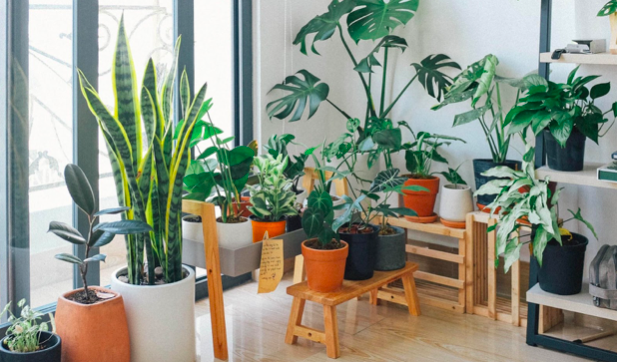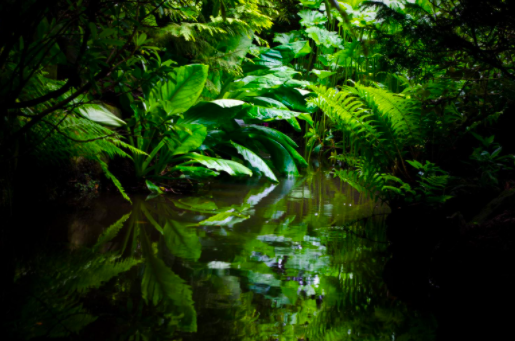
-Ginny Schafer-
I think my favorite thing about 2020 is the fact that it’s almost over. My second favorite thing is that this is the year that I finally learned enough about houseplants to keep them happy and thriving! Before this year, I was… alright with plants. I had a few aloes that managed to stay alive, but other than that, the average life expectancy of a plant in my house was about 5 months. Then along came 2020, and diving headfirst into houseplants and plant care was a great distraction from, well, pretty much everything. Now, I’m running out of room in front of my windows! I’d like to share, in no particular order, a few things I learned I was doing wrong, and what I started doing right.
Helpful: Strategic placement
My plant-buying process used to look something like this: I’d get a plant, put it wherever I thought it looked cool, then a few months later it would die. I used to blame this on the fact that the house I was living in got very little sunlight, but the real problem was me. I was getting parlor palms, sundews, and cacti; all plants that need medium to bright indirect light and expecting them to thrive in low light conditions. I should have been getting sansevieria, pothos, and other low light tolerant plants. Now, my plant-buying process is more like this: I see a plant I like, research its light requirements, and think about whether or not I have any free space in a spot that meets those needs. If so, I’ll probably get that plant. If not, then it would be better off with someone who can take care of it.

Not helpful: Putting your plants in direct sunlight
In the wild, most of the plants that we enjoy as houseplants grow on the forest floors of tropical rainforests. Therefore, most houseplants thrive on bright indirect light resembling the dappled light that filters through the canopies of tall rainforest trees. If you notice that your plants’ leaves are turning brown and crispy, it could be sunburn, especially if your plant is directly in front of a south facing window. Try moving it a few feet back, or off to the side instead!
Helpful: Watering plants from the bottom up
This was a game changer for me, y’all. The ideal watering method for carnivorous plants, I was surprised at how often I use this method at home. Here’s how it works: fill a bowl or large saucer with water, set your plant down in it, and leave it there until the top of the soil is damp. That’s it! This is especially helpful for watering plants potted in peat moss, which can be a real pain to water if it dries out completely. Just be sure to take your plant out of the water when it’s done, or you’ll be inviting root rot.
Not helpful: Watering your plants every day
DO NOT DO THIS. The vast majority of plants will get root rot if you water them every day, I promise. Even plants that like consistently damp soil, like ferns and calatheas, don’t want soggy, waterlogged soil. Ideally, you want their soil to feel like a damp sponge that’s just been wrung out. The only exceptions to this are bonsai trees, which need to be watered up to twice a day in the summer; and carnivorous plants, which should constantly sit in water. If you find that your plants are so dry that you do have to water them every day, it’s time to repot!
Helpful: Using neem oil as a leaf polish (and preventative)
Dilute about a teaspoon of neem oil with water in a spray bottle, spray it onto a soft rag, then gently wipe the leaves with it. This will remove any dust and residue from pesticides. Using a neem oil polish doesn’t just make your plants look nicer, it also helps them absorb more sunlight and prevents pest infestations!
Not helpful: Using neem oil to treat pests
While neem oil is great at preventing pests, it’s not very good at getting rid of them. For that, you’ll want to use an insecticidal soap or, depending on what kind of pest you have, something stronger. If you’re looking for an all-in-one pest preventer/pesticide, PureCrop 1 is your best bet. It also protects plants against fungus, mold, and mildew.
Not helpful: Misting your plants
I hate to say it, but misting hasn’t been all that helpful for keepindyg my moisture-loving plants alive. Those tiny droplets of water evaporate so quickly, you’d have to mist your plants several times a day to keep the humidity at a level they like. Now, if you’re working from home, you might be able to do that, in which case this is a helpful tip!
Helpful: Pebble trays
Instead, I’ve found that putting my plants in a tray filled with hydroton and water is much more helpful in creating a humid environment. The hydroton keeps the plants above the water so they don’t accidentally get overwatered. As the water in the tray evaporates, it makes the air around your plants just a little more humid, just the way they like it!
Helpful: Fertilizing your houseplants
Ok, this probably seems like a no-brainer to most of you, but before this year, I didn’t think fertilizer was all that necessary! I used to think houseplant fertilizer was for impatient people who didn’t want to wait for their houseplants to get to an impressive size. This year, it finally dawned on me that fertilizer is food for your plants! In the wild, decomposing organic matter is constantly replenishing the nutrients in the soil. Since we don’t have an entire ecosystem surrounding our indoor potted plants, they need fertilizer to give them those nutrients, especially in the spring and summer.
Not helpful: Over-fertilizing your houseplants
More isn’t always better, especially when it comes to fertilizer. As with watering, every houseplant has different fertilizing needs. For most plants, the recommended dilution on the fertilizer bottle will do, but some plants are more sensitive and might need fertilizer that’s diluted to half strength, even in the spring and summer. In fact, over-fertilization can make leaves turn brown or curl, and make your plant more susceptible to pests and disease. To avoid this, I fill my watering can with the standard dose of Dyna-gro (1 tsp per gallon) and water all my plants that need that standard dose. I usually have about half a can of water left. I refill it with just water, and continue watering the plants that need lower strength fertilizer. It takes some research, but your plants will thank you!
What plant care tips will you be taking into 2021, and which ones will you be leaving in this dumpster fire of a year? Let us know in the comments! Have a Happy New Year, everyone!



bug guy says
We love the PureCrop 1 pesticide. We recommend it to all of our plant-loving clients.
Happy New Year!
christine says
Your comment states Neem oil is a great leaf polish and pest preventer yet next comment states it can nit get rid of pests. 100% cold pressed Neem oil is used by gardeners to prevent, and eliminate pests providing you use as directed. What you buy in the stores has been refined and chemicals added and is a god choice. I personally eliminated meely bugs I had on my Swiss Cheese plant. Now you do have to be diligent and pay attention to your plants for any resurgance. 100% Neem oil is all I use My opinion as a Professional Gardner
Mike Tyler says
Thanks for these tips and tricks, they seem legit, I just started growing plants, and always mess things up. I will try to remember the things you have mentioned in the blog.